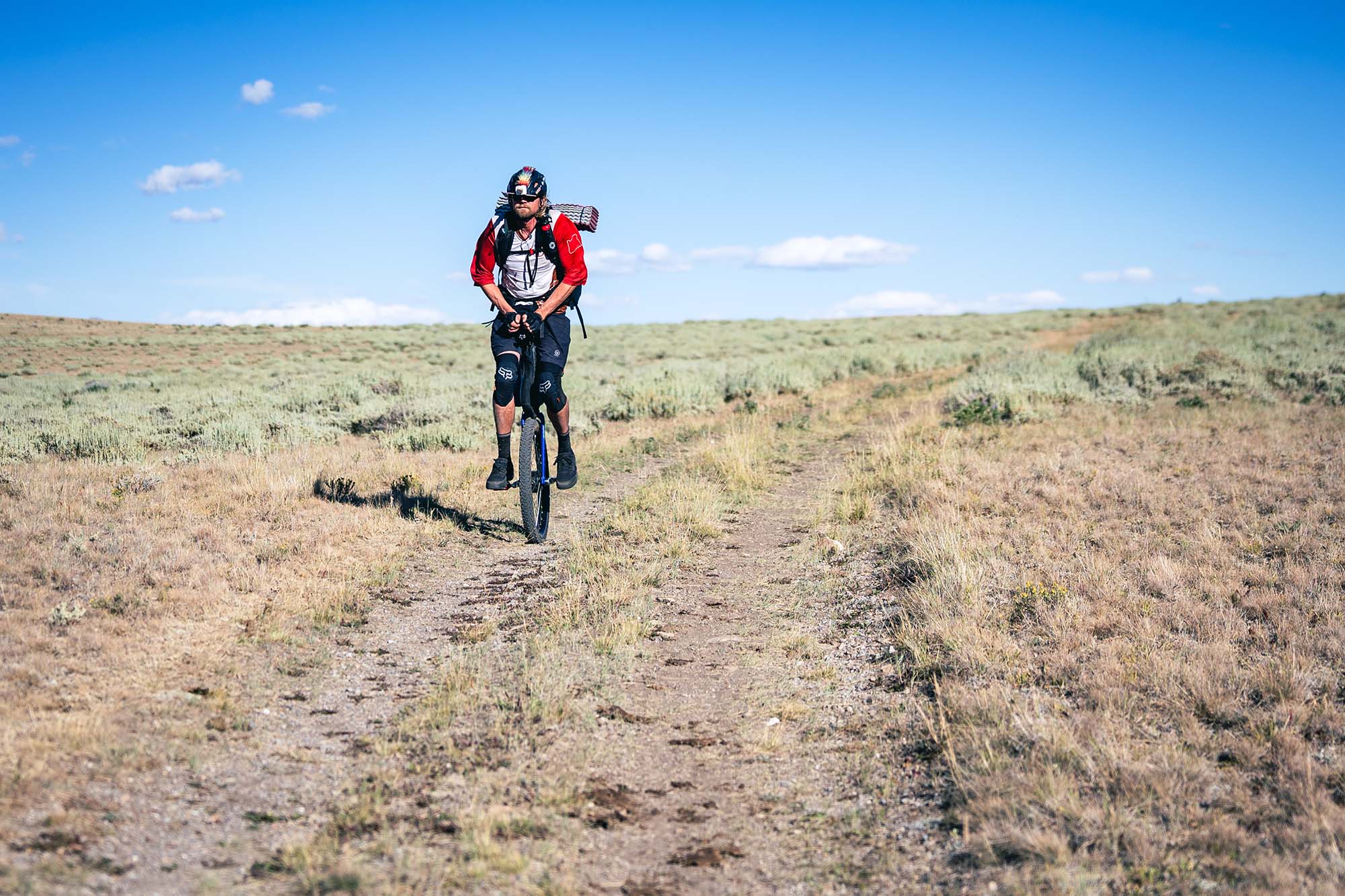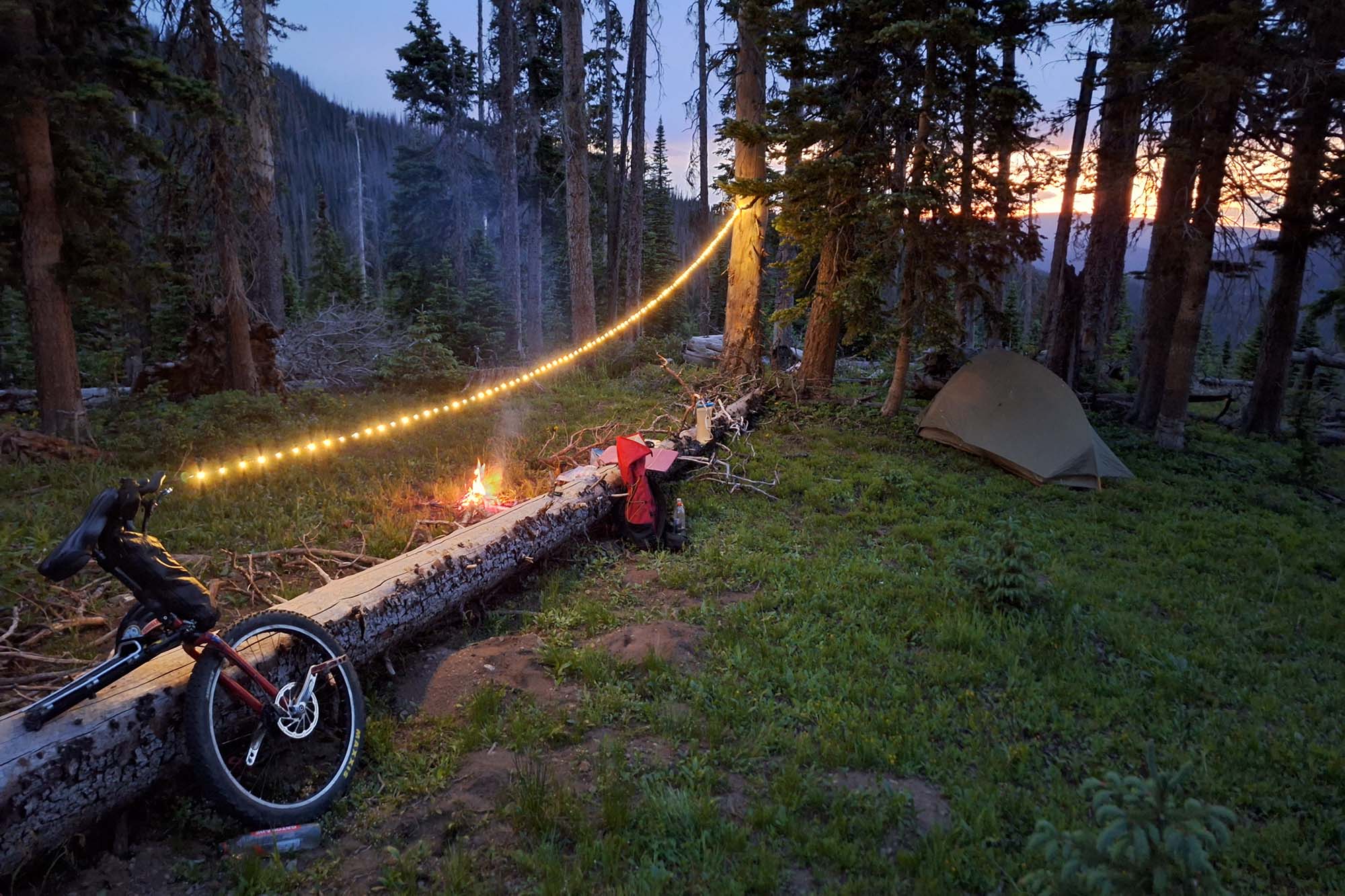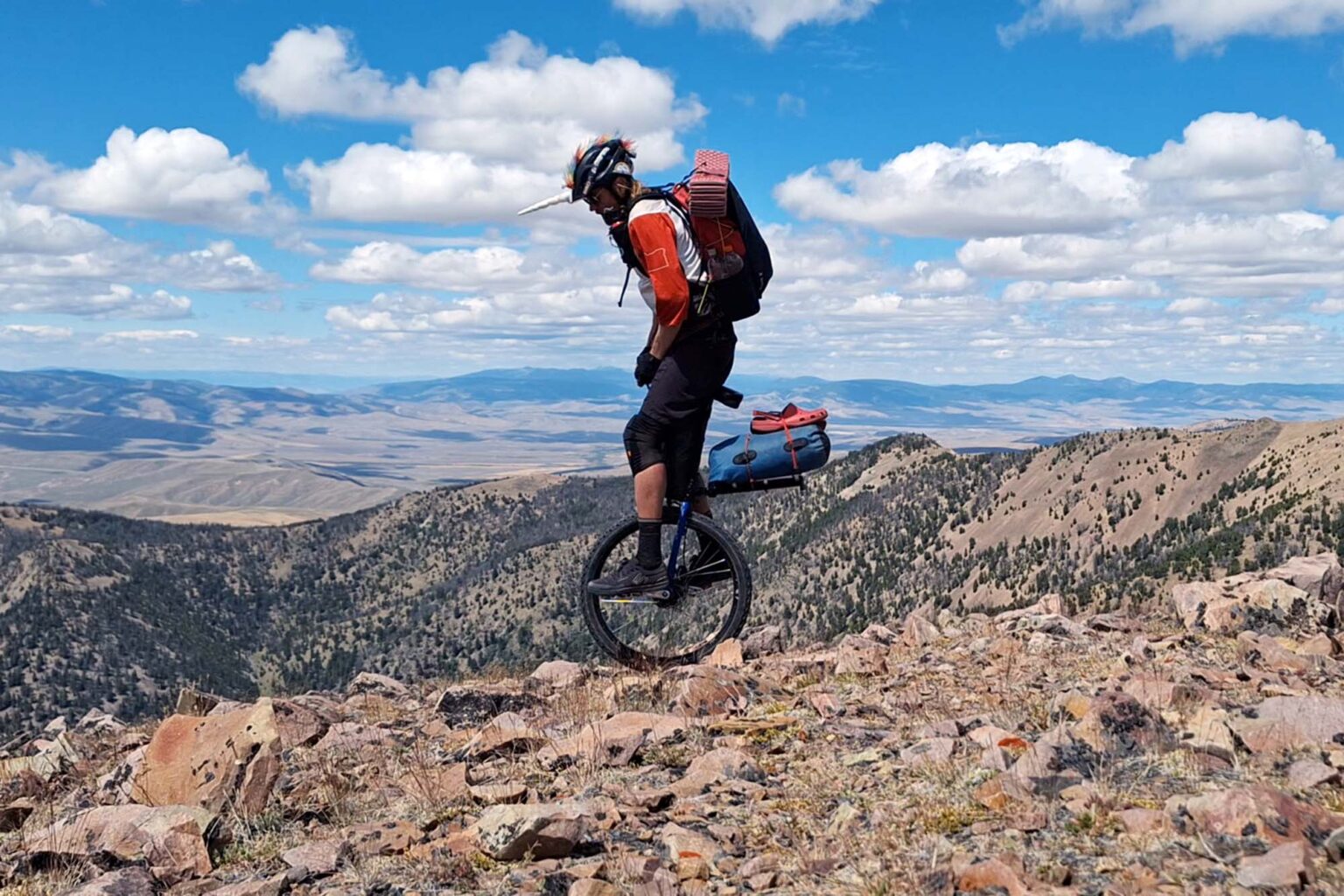The unicycling adventures of Jamey Mossengren have always included a certain zany cuteness. If you’re familiar with the “Unicycling Unicorn,” it’s probably through his stage or street performances, where he wears a colorful unicorn costume and rides a 12-foot-tall unicycle while juggling swords — among many other jaw-dropping tricks.
This 46-year-old Minnesotan has also made a name for himself among outdoor athletes by conquering tough trails that challenge even experienced hikers and bikers, like unicycling his way through the entire 500-mile Colorado Trail.
But this year was different. On January 1 this year, Mossengren’s sister took her own life. Her passing “left a hole in my heart that felt impossible to fill,” he told GearJunkie. Consumed by grief, he soon canceled several of his regular summer gigs.
“I’m a professional performer, and it was hard to make other people happy when I wasn’t happy,” he said.
It wasn’t long before Mossengren latched onto a new idea: escape to the mountains. So this summer, he tackled what could be one of the most intense endurance challenges ever accomplished on a unicycle. Adorned with his trademark rainbow mohawk-and-unicorn-horn helmet, Mossengren pedaled more than 1,000 miles of the rugged Continental Divide Trail.
“I used the trail to help heal me,” he said. “I had to learn how to forgive myself for not helping her, and how to forgive her for doing what she did.”
Unicycle the Continental Divide
If you’re wondering how, exactly, one would unicycle the Continental Divide Trail (CDT) — you’re not the only one. Though Mossengren is an experienced hiker and endurance athlete, taking on the CDT with a unicycle presented a host of new challenges.
The 3,100-mile trail traverses the Rocky Mountains from the southern border in New Mexico to the Canadian border at Glacier National Park. In 2023, Mossengren hiked about half of the trail with some friends, but it wasn’t a continuous route. They skipped snowy or impassable sections of the trail by hopping back in a vehicle and driving to their next preferred entry point.
So, Mossengren came up with a creative idea: What if he went back to finish off those missed sections of the CDT, but using his unicycle? He liked the idea, but it presented some immediate problems. Many portions of the CDT cross wilderness areas, where the use of a bike (or unicycle, in this case) is prohibited.
And when he could use the unicycle, he’d have to keep everything he needed for backpacking strapped to his single wheel or stashed in his small backpack.
‘Seven-Wheel Strategy’
But Mossengren was undeterred. To navigate the complicated logistics and still tackle the challenge all by himself, he eventually latched onto what he calls a “seven-wheel strategy,” referring to his Sprinter van, moped, and trusty unicycle. He would park the van at a trailhead, scooter north with the unicycle strapped to the moped, ride the unicycle south back to the van — then start all over again with the next trail section.
This repetitious system was exhausting and exhilarating, often in equal measure.
“It was harder than I thought it would be,” Mossengren said. “There were some days when I was cussing and swearing because the trail is overgrown and not rideable. And I’d ask myself, ‘Why am I doing this?’ Then the next day would be beautiful and have 4,000 feet of downhill, and then I’d be like, ‘Oh yeah, this is why.’”

Off-Road Unicycling
You’d be forgiven if you’ve never heard of “mountain unicycling.” But the niche sport has roots going back to the late 1990s. Most unicyclists, including Mossengren, credit Canadian athlete Kris Holm as almost single-handedly kicking off the sport.
Holm grew up in Vancouver, British Columbia. From a young age, he was captivated by a unicycling street performer and decided to tackle the province’s world-famous mountain biking trails on a unicycle. But there were no mountain unicycles to ride — they just didn’t exist yet.
During his first attempt at filming his stunts in the 1990s, Holm actually broke the unicycle he was using. So he asked a local machine shop to build him an off-road unicycle from scratch, he said in a 2023 interview. Fast-forward to today, and Kris Holm Unicycles have become the sport’s go-to brand.
As Mossengren took on 1,200 miles of the CDT this summer, he used a Kris Holm Unicycle nearly the entire distance. It weighs about 15 pounds, with a tire measuring 27.5 x 2.4 inches.
Though the unicycle served Mossegren well, its bearings finally wore out near the end of his journey. In August, with a week left to traverse the final 100 miles of trail, Mossengren was forced to use his spare unicycle. With its geared hub, the backup unicycle weighed about 10 pounds more than the Kris Holm model that had rolled over hundreds of miles of Rocky Mountain trails.
“I was able to barely finish with bearings that weren’t very good,” Mossengren said. “So I went through two sets of bearings.”

Memories & Trail Magic
As Mossengren used his fixed-gear unicycle to descend the CDT’s steep, rocky trails, he constantly turned the heads of perplexed thru-hikers. After all, when faced with a long uphill ascent, Mossengren mostly pushed his loaded unicycle along in front of him, then hopped back on when it was time for the descent.
“A lot of times people would ask me, ‘Why would you unicycle this trail?’” he said. “And I’m like, ‘Why would you hike from Mexico to Canada when you could drive it?’”
Mossengren did sometimes feel like he was “cheating,” but only when he returned to the Sprinter van he calls home, and enjoyed the comforts of a hot meal and a roof over his head. Even though he spent most of this summer alone in the mountains, he frequently used his Sprinter van to offer a bit of “trail magic,” or random kindness. At several trailheads, Mossengren served up spaghetti dinners and cocktails to hikers in need of a respite.
Those moments were a nice break from his inner turmoil. Each day on the trail began with tears — an involuntary ritual that gradually faded as he put more and more miles behind him.
“Every day I wasn’t in a great mood. I was so sad and mad a lot of the time,” he said. “I’m not that religious, but Mother Nature and the mountains are my religion … When I’m there and present, I learned to forgive and heal. The trail helped me with that.”

Looking to the Future
Mossengren didn’t set out to make the ride a fundraiser. But by the time he finished, he decided to donate $1,000 to the American Foundation for Suicide Prevention. Throughout his journey, Mossengren published updates to social media, and encourages others to make a donation of any amount to the nonprofit.
“Please call 988 or even send me a DM if you need help,” he said.
At this point, Mossengren feels well acquainted with the power of nature to help process grief. He spent 3 weeks unicycling the Colorado Trail in 2015 following a divorce from his ex-wife: “When I ended that, I was a totally different person. It just helped me to let go and move on.”
He feels something similar after this year’s 2-month journey on the CDT. After starting in Grants, N.M., in mid-June, he finished the trip on August 14, pedaling and hiking to a finish near Yellowstone National Park. Now that he’s finally done, Mossengren can’t say for sure that it fixes everything. But it’s a start.
After dropping his summer performances for this personal quest, he’s back performing as the “Unicycling Unicorn” in Boston. For the next month, you can watch him perform each weekend at the city’s King Richard’s Faire.
“Spending two months in nature doesn’t necessarily make things a lot better,” he said. “But maybe a little better.”
Read the full article here





